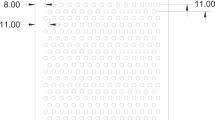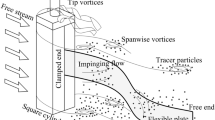Abstract
Particle Image Velocimetry (PIV) and direct force measurements are used to investigate the effect of transverse perforations on the flow-induced loading on and the associated flow structure around flat plates that are aligned with the oncoming flow. Plates with different characteristic diameter of the perforations, as well as a reference configuration without perforations are compared in terms of the spectra of the flow-induced forces, frequencies of the trailing edge vortex shedding and boundary layer profiles at the trailing edge at different planes across the perforation patterns for a range of inflow velocities. At high inflow velocities, boundary layer thickness increased as the diameter of the perforations increased and the distance from the perforation to the trailing edge of the plate decreased.
Access provided by Autonomous University of Puebla. Download conference paper PDF
Similar content being viewed by others
Keywords
1 Introduction
Rectangular plates aligned with the incoming fluid flow and the associated flow field, flow-induced loading, noise and vibrations have been subjects of a number of studies over the years, which examined the effects of the Reynolds number [6], chord-to-thickness ratio of the plate [5], array configurations [7] and wall confinement [4]. Effects of elasticity and porosity of the leading edge of a semi-infinite plate on radiated acoustic noise were investigated theoretically by [3], and the related experimental measurements of the fluctuating pressure due to flow over a porous surface with flexible bristles were performed by [2]. Directly related to the present study is the investigation of the effect of transverse perforations on loading on plates of finite thickness using direct force measurements [1]. In the present investigation, we employed PIV and direct force measurements in order to provide insight into the physical origin of the flow-induced loading on and the vibrations of the perforated plates.
2 Experimental System and Techniques
The experiments were conducted in a flow visualization water channel with a test section with square cross-section of 45 cm × 45 cm and a length of 250 cm. The flat plates were positioned parallel to the flow. The plates were cantilevered at the top edge and attached to the frame of the water channel by a support structure that incorporated a load cell for direct force measurements (Fig. 1a). Three plates with transverse perforations were considered, in addition to a reference plate with no perforations. The three perforation patterns had the same staggered arrangement, but different perforation diameters δ h = 9.4, 12.7, 19.5 mm, referred to as patterns P1, P2 and P3, respectively. The spacing between the perforations was also equal to δ h , so that the three plates had the equivalent area ratio, (nA p /A t )0.5 = 0.4, where n is the number of perforations, A p is the area of a single perforation, A t is the total wetted area of the plate. Global measurements of the flow velocity in the vicinity of the trailing edge of the plate were performed using high-speed PIV. A total of 6000 images were recorded during each data acquisition, at the sampling rate of 600 Hz and the spatial resolution of 1.05 vector/mm and 0.54 vector/mm for the solid and perforated plates, respectively. As illustrated in Fig. 1b, three PIV data acquisition planes (DAPs) were defined to characterize the three-dimensionality of the flow. For the case of the solid plate, the data acquisition was performed only in DAP3. In order to study the vortex shedding frequencies, the power spectral density (PSD) of the time signal of the transverse velocity fluctuations (U′ y ) was calculated. U′ y was obtained by subtracting the time-averaged transverse velocity component from that of the instantaneous velocity field.
3 Results and Discussion
3.1 Unsteady Loading
Figure 2 shows the plots of the PSD of the time signals of the unsteady flow-induced torque on the plate (Fig. 2a) as well as the transverse velocity fluctuations U′y (Fig. 2b), for the plate with the largest perforation diameter (P3). Figure 2b was obtained from the velocity field corresponding to DAP1. With the exception of the case of U = 0.55 m/s, the load cell peak frequencies, f LC , (Fig. 2a) and the vortex shedding frequencies, f PIV , (Fig. 2b) both increased linearly with the increase of the inflow velocity. Additionally, at U = 0.37, 0.46 and 0.55 m/s, the PSD values of the force signal show an increase (blue symbols in Fig. 2a) at frequencies close to the natural vibrational frequency of the plate (f 0 = 7.8 Hz). Figure 2 also shows that, at U = 0.55 m/s, f LC and f PIV remained locked-on to the natural vibrational frequency of the plate. As a result, vibrations with 1 mm displacement amplitude were observed at the leading and trailing edges of the plate P3.
3.2 Boundary Layer Profiles
Figure 3 shows the time-averaged boundary layer profiles at the trailing edge of the plate with the largest perforations (P3) for five different inflow velocities, corresponding to the cases presented in Fig. 2. In order to provide a reference, velocity profiles for the solid plate are shown in all plots. The corresponding boundary layer profiles for the plates with smaller perforation diameters (P1 and P2) match those of the solid plate for all values of the inflow velocity, considering the inherent uncertainty of the PIV measurements, and are not presented here. As the perforation diameter increased to δ h = 19.5 mm, the boundary layer profiles deviated from those corresponding to the solid plate for all inflow velocities. This deviation was particularly pronounced close to the surface of the plate, and it increased with the increase of the inflow velocity. Moreover, larger difference between the boundary layer profiles of the perforated plate and that of the solid plate was observed at DAP1 (Fig. 3a) compared to DAP3 (Fig. 3b). The separating boundary layer corresponding to DAP1 was influenced by the proximity of the most downstream perforation, which was located closer to the trailing edge of the plate in DAP1 than it was in DAP3. From a theoretical standpoint, the fluctuating pressure difference between the upper and the lower surfaces of the plate is proportional to the velocity fluctuations in the perforations [3]. In turn, the pressure difference at the trailing edge governs the process of periodic trailing edge vortex shedding. The present results indicate that the fluctuating pressure difference across the plate was reduced in the vicinity of the individual perforations. Thus, the staggered perforation pattern disrupted the trailing vortex shedding to various degrees along the span of the plate and introduced three-dimensionality to the wake. In the time-averaged sense, increasing the perforation diameter resulted in a wider wake, thus increasing the bluffness of the plate, defined as the ratio of the wake width to the thickness of the plate, following the notation of [8] developed for generalized bluff bodies.
4 Conclusion
The effect of the diameter of the transverse perforations and inflow velocity on the frequency and amplitude of the flow-induced loading was investigated using direct force measurements and PIV. The vortex shedding frequencies were in good agreement with the frequencies of the measured flow-induced loading for all perforation patterns. Thus, it was determined that the trailing edge vortex shedding was the main mechanism of generating the loading on the plates and the resulting flow-induced vibrations. Although not presented in this paper, the frequency of the vortex shedding and of the loading on the plates decreased with the increase of the perforation diameter. The thickness of the boundary layer at the trailing edge also increased with the increasing diameter of the perforations at the highest considered inflow velocities. Therefore, the decrease of the frequency of velocity oscillations in the wake can be attributed to the increase of the boundary layer thickness at the point of flow separation. The largest perforation diameter resulted in a three-dimensional boundary layer whose thickness, as well as the deviation of the velocity profile from the reference case of solid plate, increased with the decrease of the distance of the last (downstream-most) perforation from the trailing edge.
References
Bossi FC, Barannyk O, Rahimpour M, Malavasi S, Oshkai P (2016) Effect of transverse perforations on fluid loading on a long, slender plate at zero incidence. J Hydrol Hydromech 65
Clark I, Devenport WJ, Jaworski J, Daly C, Peake N, Glegg SA (2014) The noise generating and suppressing characteristics of bio-inspired rough surfaces. In: 20th AIAA/CEAS aeroacoustics conference, the AIAA aviation forum, Atlanta, USA, 16–20 June 2014
Jaworski JW, Peake N (2013) Aerodynamic noise from a poroelastic edge with implications for the silent flight of owls. J Fluid Mech 723:456–479
Malavasi S, Zappa E (2008) Fluid-dynamic forces and wake frequencies on a tilted rectangular cylinder near a solid wall. Meccanica 44:91–101
Nakamura Y, Ohya Y, Tsuruta H (1991) Experiments on vortex shedding from flat plates with square leading and trailing edges. J Fluid Mech 222:437–447
Okajima A (1982) Strouhal numbers of rectangular cylinders. J Fluid Mech 123:379–398
Parker R (1966) Resonance effects in wake shedding from parallel plates: Some experimental observations. J Sound Vibr 4:62–72
Roshko A (1955) On the wake and drag of bluff bodies. J Aeronaut Sci 22:124–132
Acknowledgements
The authors gratefully acknowledge the financial contribution of PIBIVIESSE s.r.l. to the Ph.D. scholarship of F. Bossi and financial support of the Natural Sciences and Engineering Research Council of Canada.
Author information
Authors and Affiliations
Corresponding author
Editor information
Editors and Affiliations
Rights and permissions
Copyright information
© 2019 Springer Nature Singapore Pte Ltd.
About this paper
Cite this paper
Oshkai, P., Bossi, F., Rahimpour, M., Barannyk, O., Malavasi, S. (2019). Experimental Investigation of Flat Plates with Transverse Perforations at Zero Incidence. In: Zhou, Y., Kimura, M., Peng, G., Lucey, A., Huang, L. (eds) Fluid-Structure-Sound Interactions and Control. FSSIC 2017. Lecture Notes in Mechanical Engineering. Springer, Singapore. https://doi.org/10.1007/978-981-10-7542-1_46
Download citation
DOI: https://doi.org/10.1007/978-981-10-7542-1_46
Published:
Publisher Name: Springer, Singapore
Print ISBN: 978-981-10-7541-4
Online ISBN: 978-981-10-7542-1
eBook Packages: EngineeringEngineering (R0)







